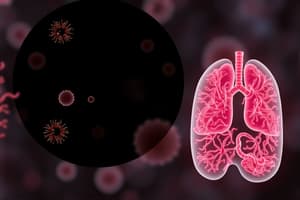Podcast
Questions and Answers
What is the primary function of respiration in living organisms?
What is the primary function of respiration in living organisms?
- Maintain homeostasis
- Regulate body temperature
- Convert biochemical energy into ATP (correct)
- Synthesize glucose
What distinguishes aerobic respiration from anaerobic respiration?
What distinguishes aerobic respiration from anaerobic respiration?
- Production of carbon dioxide
- Requirement of oxygen (correct)
- Generation of water
- Use of hydrogen sulfide
In which organelle of eukaryotic cells does aerobic respiration primarily take place?
In which organelle of eukaryotic cells does aerobic respiration primarily take place?
- Endoplasmic reticulum
- Golgi apparatus
- Mitochondria (correct)
- Nucleus
Which type of respiration produces significantly more ATP per mole of glucose?
Which type of respiration produces significantly more ATP per mole of glucose?
What is the energy currency produced by both aerobic and anaerobic respiration?
What is the energy currency produced by both aerobic and anaerobic respiration?
Which process occurs in the cytosol of the cell and produces two molecules of ATP and two molecules of pyruvate from one molecule of glucose?
Which process occurs in the cytosol of the cell and produces two molecules of ATP and two molecules of pyruvate from one molecule of glucose?
What is the main end product of lactic acid fermentation?
What is the main end product of lactic acid fermentation?
In which organelle does oxidative phosphorylation take place?
In which organelle does oxidative phosphorylation take place?
What is the significance of anaerobic respiration in sustaining life processes?
What is the significance of anaerobic respiration in sustaining life processes?
How does respiration regulate body temperature?
How does respiration regulate body temperature?
Flashcards
Respiration
Respiration
The process by which organisms convert energy from food molecules into a usable form (ATP) for cellular activities.
Aerobic respiration
Aerobic respiration
Respiration in the presence of oxygen, resulting in higher ATP production compared to anaerobic respiration.
Anaerobic respiration
Anaerobic respiration
Respiration in the absence of oxygen, producing less ATP than aerobic respiration.
Glycolysis
Glycolysis
Signup and view all the flashcards
Citric Acid Cycle (TCA cycle)
Citric Acid Cycle (TCA cycle)
Signup and view all the flashcards
Oxidative Phosphorylation
Oxidative Phosphorylation
Signup and view all the flashcards
Fermentation
Fermentation
Signup and view all the flashcards
Anaerobic respiration in prokaryotes
Anaerobic respiration in prokaryotes
Signup and view all the flashcards
Significance of respiration
Significance of respiration
Signup and view all the flashcards
Mitochondria
Mitochondria
Signup and view all the flashcards
Study Notes
Life Processes: A Focus on Respiration
Life is a dynamic and enthralling process, where organisms continually interact with their environment to maintain homeostasis. At the heart of this interaction lies a fundamental life process known as respiration. In this article, we'll delve into the concept of respiration and its essential role in sustaining life.
Respiration: Definition and Functions
Respiration is the process whereby living organisms convert biochemical energy stored in food molecules into a form that can be used to fuel cellular activities. It also serves to remove waste products and regulate body temperature.
There are two types of respiration—aerobic respiration and anaerobic respiration. Aerobic respiration occurs in the presence of oxygen, while anaerobic respiration does not. Both processes provide energy in the form of adenosine triphosphate (ATP), but aerobic respiration produces much more ATP per mole of glucose than anaerobic respiration.
Aerobic Respiration
Aerobic respiration is the most common form of respiration in most living organisms. It occurs within the cells of eukaryotes, such as plants and animals, and involves a series of metabolic reactions that break down glucose in the presence of oxygen to produce ATP.
The process primarily takes place in the mitochondria of eukaryotic cells. Mitochondria, often referred to as "cellular powerhouses," convert the energy stored in glucose molecules into ATP through a specialized series of metabolic pathways.
- Glycolysis: Occurs in the cytosol of the cell and results in the production of two molecules of ATP and two molecules of pyruvate from one molecule of glucose.
- Citric Acid Cycle (TCA cycle): Occurs in the mitochondrial matrix and further breaks down pyruvate into carbon dioxide, water, and high-energy electrons.
- Oxidative Phosphorylation: Also known as the electron transport chain, this process occurs in the inner mitochondrial membrane and uses the energy released from the flow of electrons to pump protons across the membrane. This generates a proton gradient, which is used to produce ATP through a process called chemiosmosis.
Anaerobic Respiration
Anaerobic respiration occurs in the absence of oxygen. It is a less efficient form of respiration than aerobic respiration, producing less ATP per mole of glucose.
Anaerobic respiration can be divided into two main types:
- Fermentation: Involves simpler organisms, such as bacteria, yeast, and some protozoans. For example, lactic acid fermentation produces lactic acid from glucose, while alcoholic fermentation produces ethanol and carbon dioxide.
- Anaerobic respiration in prokaryotes: Occurs in archaebacteria and some bacteria, such as methanogens and sulfate-reducing bacteria, which produce methane or hydrogen sulfide, respectively, as end products.
The Significance of Respiration
Respiration plays a vital role in the life processes of organisms. It:
- Provides the energy required for cellular activities.
- Produces water and carbon dioxide as waste products, which can be eliminated through other life processes, such as osmoregulation, excretion, and photosynthesis.
- Regulates body temperature through the production of heat as a byproduct of respiration.
- Maintains acid-base balance in cells.
Respiration is an essential life process that allows living organisms to interact with their environment and sustain life. Understanding respiration and its various forms is crucial to our understanding of life and its processes at all levels of organization.
Studying That Suits You
Use AI to generate personalized quizzes and flashcards to suit your learning preferences.




